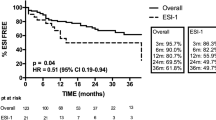Abstract
Catheter replacement and cuff-shaving are performed as a surgical treatment against tunnel infection (TI) in patients on chronic peritoneal dialysis. The efficacy of catheter replacement is well established, but that of cuff-shaving is not. For the purpose of evaluating the efficacy of cuff-shaving, we compared the time interval between each procedure and subsequent TI. In order to perform this comparison, we reviewed data from 32 cuff-shaving procedures and 29 catheter replacement procedures at Tokyo Metropolitan Kiyose Children’s Hospital in the period from 1 March 1991 to 1 May 2001, retrospectively. There was no significant difference in the time interval between each procedure and subsequent TI ( P =0.284). The incidence of recurrence was no more than 12.5% for the cuff-shaving procedures. The incidence of peritonitis due to post-surgery TI with the cuff-shaving procedures was 9.3% and 6.8% with the replacement procedure ( P =0.725). There was no significant variation in time interval to post-cuff-shaving TI according to the reason for the cuff-shaving procedure. In conclusion, cuff-shaving may be worth considering for TI in adequately selected patients.





Similar content being viewed by others
References
Honda M (1999) The 1997 report of the Japanese National Registry data on pediatric peritoneal dialysis patients. Perit Dial Int 19 [Suppl 2]:473–478
Honda M (1999) The Japanese experience with CAPD/CCPD in children. In: Fine RN, Alexander SR, Warady BA (eds) CAPD/CCPD in children, 2nd edn. Kluwer Academic Science, Boston, pp 301–348
Verrina E, Honda M, Warady BA, Piraino B (2000) Prevention of peritonitis in children on peritoneal dialysis. Perit Dial Int 20:625–630
Piraino B, Bernardini J, Sorkin M (1986) The influence of peritoneal catheter exit-site infections on peritonitis, tunnel infections, and catheter loss in patients on continuous ambulatory peritoneal dialysis. Am J kidney Dis 8:436–440
Nichols WK, Nolph KD (1983) A technique for managing exit-site and cuff infection in Tenckhoff catheters. Perit Dial Bull 3 [Suppl]:4–5
Laurent MST, Surendranath C, Saad T, Halff G, Esterl R JR (1998) A new salvage procedure for peritoneal dialysis catheters with exit-site infections. Am J Surg 64:1215–1217
Majkowski NL, Mendley SR (1997) Simultaneous removal and replacement of infected peritoneal dialysis catheters. Am J Kidney Dis 29:706–711
Schröder CH, Severijnen RSVM, Jong MCJW de, Monnens LAH (1993) Chronic tunnel infections in children: removal and replacement of the continuous ambulatory peritoneal dialysis catheter in single operation. Per Dial Int 13:198–200
Scalamogna A, Castelnovo C, De Vecchi A, Ponticelli C (1991) Exit-site and tunnel infections in continuous ambulatory peritoneal dialysis patients. Am J Kidney Dis 18:674–677
Scalamogna A, De Vecchi A, Maccario M, Castelnovo C, Ponticelli C (1995) Cuff-shaving procedure. A rescue treatment for exit-site infection unresponsive to medical therapy. Nephrol Dial Transplant 10:2325–2327
Herlfrich GB, Winchester JF (1982) Questions and answers: ‘shaving’ of the subcutaneous cuff may cure persisting skin exit infection. However, in attempting this procedure one may damage the permanent catheter. Could you describe the details of this technique? Perit Dial Bull 2:183
Suh H, Wadhwa NK, Cabralda T, Bonanno J, Wasiluk A, Sorrento J (1997) Persistent exit-site/tunnel infection and subcutaneous cuff removal in PD patients. Adv Perit Dial 13:233–236
Piraino B, Bernardi J, Peitzman A, Sorkin M (1987) Failure of peritoneal catheter cuff shaving to eradicate infection. Perit Dial Bull 7:179–182
Holley LJ, Bernardi J, Piaino B (1991) Risk factor for tunnel infections in continuous peritoneal dialysis. Am J Kidney Dis 18:344–348
Abraham G, Savin E, Ayiomamitis A, Izatt S, Vas SI, Mathews RE, Oreopoulos DG (1988) Natural history of exit-site infection (ESI) in patients on continuous ambulatory peritoneal dialysis (CAPD). Perit Dial Int 8:211–216
Piraino B, Bernardini J, Sorkin M (1987) A five-year study of microbiologic results of exit-site infections and peritonitis in continuous ambulatory peritoneal dialysis. Am J Kidney Dis 10:281–286
Sewell C, Clarridge J, Lacke C (1982) Staphylococcal nasal carriage and subsequent infections in peritoneal dialysis patients. JAMA 248:1493–1495
Lerner GR, Warady BA, Sullivan EK, Alexander SR (1999) Chronic dialysis in children and adolescents. Pediatr Nephrol 13:404–417
Warady BA, Sullivan EK, Alexander SR (1996) Lessons from the peritoneal dialysis patient database: a report of the North American Pediatric Renal Transplant Cooperative Study. Kidney Int 49 [Suppl 53]:S68–S71
The Mupirocin Study Group (1996) Nasal mupirocin prevents Staphylococcus aureus exit-site infection during peritoneal dialysis. J Am Soc Nephrol 7:2403–2408
Kingwatanakul P, Warady BA (1997) Staphylococcus aureus nasal carriage in children receiving long-term peritoneal dialysis. Adv Perit Dial 13:281–284
Mylotte JM, Kahler L, Jackson E (1999) “Pulse” nasal mupirocin maintenance regimen in patients undergoing continuous ambulatory peritoneal dialysis. Infect Control Hosp Epidermol 20:741–745
Verrina E, Honda M, Warady BA, Piraino B (2000) Prevention of peritonitis in children on peritoneal dialysis. Perit Dial Int 20:625–630
Crabtree JH, Hadnott LL, Burchette RJ, Siddiqi RA (2000) Outcome and clinical implications of surveillance and treatment program for Staphylococcus aureus nasal carriage in peritoneal dialysis patients. Adv Perit Dial 16:271–275
Araki Y, Hataya H, Ikeda M, Ishikura K, Honda M (2003) Intranasal mupirocin does not prevent exit-site infections in children receiving peritoneal dialysis. Perit Dial Int 23:267–269
Warady BA, Schaefer F, Holloway M, Alexander S, Kandert M, Piraino B, Salusky I, Tranaeus A, Divino J, Honda M (2000) Consensus guidelines for the treatment of peritonitis in pediatric patients receiving peritoneal dialysis. Perit Dial Int 20:610–624
Piraino B (2004) New insights on preventing and managing peritonitis. 19:125–127
Acknowledgements
We thank Professor T. Nagai and Dr. K. Obata from the Department of Pediatrics, Dokkyo University School of Medicine, Koshigaya Hospital, for their kind review of the manuscript and helpful advice.
Author information
Authors and Affiliations
Corresponding author
Rights and permissions
About this article
Cite this article
Yoshino, A., Honda, M., Ikeda, M. et al. Merit of the cuff-shaving procedure in children with tunnel infection. Pediatr Nephrol 19, 1267–1272 (2004). https://doi.org/10.1007/s00467-004-1621-y
Received:
Revised:
Accepted:
Published:
Issue Date:
DOI: https://doi.org/10.1007/s00467-004-1621-y




